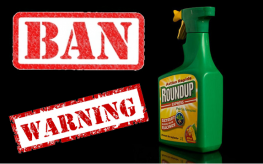Should Monsanto’s RoundUp Herbicide Be Banned?
Should Monsanto’s RoundUp Herbicide Be Banned?

A study set to be published in the August 2014 volume of Chemosphere provides solid evidence that the herbicide simply needs to be removed from circulation.
As Sayer Ji reportsover at GreenMedInfo.com, the study is simply another addition to a growing body of research detailing the current and potential damage RoundUp is capable of.
The study indicates that the classic method of testing individual molecules for toxicity won’t work with RoundUp, that it is simply:
“incapable of accurately estimating the global environmental and health risks of mixtures of agrochemicals like glyphosate (aka RoundUp) and its degradation byproduct AMPA, which are now ubiquitous environmental and food contaminants and much more harmful than previously believed.”
The researchers analyzed the “light-induced cell damaging toxicity” of glyphosate, atrazine, aminomethylphosphoric acid (AMPA), desethyl-atrazine (DEA) and various mixtures of the Roundup ingredients and metabolites.
They (and other researchers before them) came to the determination that the mixtures of herbicide ingredients and metabolites are anywhere from 20 to 1,000 times more toxic than regulators believe, as the toxic potentials of these ingredients depended largely on their physiochemical environment.
Read: Monsanto’s Roundup Ready Crops Leading to Mental Illness, Obesity.
“This study established that enhanced cytogenetic activities could be observed in pesticide mixtures containing glyphosate, atrazine, and their degradation products AMPA and DEA. It highlighted the importance of cocktail effects in environmental matrices, and pointed out the limits of usual testing strategies based on individual molecules, to efficiently estimate environmental risks.”
So, what does this mean? It means we truly don’t know just how toxic glyphosate and RoundUp are overall. As the toxicity and potential damage changes with environmental factors and chemical combinations, the current modes of analysis are just inadequate.
What’s most troubling is that glyphosate is found in our foods, and subsequently, our blood, urine, and even breast milk. It’s allowed in our food.
“When you consider that glyphosate is presently allowed in human food at levels up to six orders of magnitude higher than research has revealed may be harmful to the human body, AMPA’s potential for being 1,000 times more toxic than glyphosate implies that present day ‘acceptable levels’ may be up to 9 orders of magnitude — 1,000,000,000 times — too lax than required to protect exposed populations from significant bodily harm.”
Other Popular Stories:
Get The NaturalSociety Natural Health Newsletter!
Post a Comment